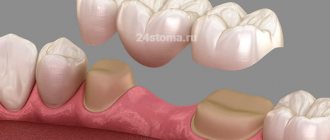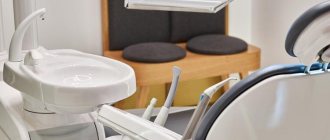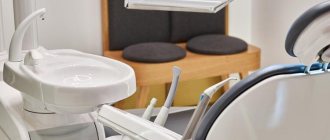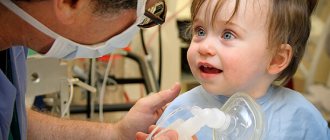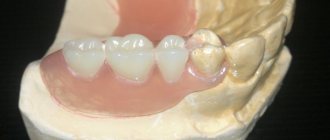04/14/2021 Today it is difficult to imagine restorative dentistry without computer programs. Manual production of dentures by casting is gradually giving way to new, accurate and fast CAD/CAM technology in dentistry.
CAD/CAM is a modern digital technique that automates the process of creating dentures: the workpiece is modeled in an electronic program and milled on a computer numerical control (CNC) machine. The technology is applicable to zirconium, titanium, cobalt-chrome, glass ceramics, etc.
What are CAD and CAM?
- CAD – Computer-Aided Design (from English computer assistance in design and modeling). After scanning the oral cavity, the model is created in virtual space using special software. As a result, the crown fits perfectly.
- CAM – Computer-Aided Manufacturing (from English computer assistance in production). Data about the modeled product is transferred to a CNC machine, where the crown is automatically turned.
With traditional cast crowns, the patient experienced discomfort when making impressions, and situations could arise where the crown did not fit exactly. In addition, the production time of the prosthesis took an average of 2-3 days, during which the patient was left with exposed, ground teeth.
Not only are cad/cam crowns more accurate and superior than their casting sisters, but they are also produced significantly faster—reducing the number of dental visits to just one. At the same time, the patient can personally observe the production of the prosthesis, and it looks impressive.
Benefits of CAD/CAM
- Creation of structures of any shape and complexity.
- No discomfort when scanning the oral cavity.
- Speedy production of orthopedic structures.
- Ability to create products from different metals, including zirconium dioxide.
- High-precision computer technology (accuracy up to 25 microns).
CAD/CAM technology is suitable for creating one-piece ceramic and metal fixed prostheses of various types: crowns, veneers, abutments, etc. This method does not have the usual disadvantages of previous technologies: shrinkage, deformation, overheating of the metal, the presence of pores and unshed areas.
Stages of creating dentures
- Preparation for prosthetics (hygiene, sanitation, preparation of supporting teeth).
- Scanning the oral cavity with an intraoral scanner.
- Electronic three-dimensional modeling of an individual Ked/Kam crown.
- Automatic turning on a milling machine.
- Sintering and grinding.
What cad/cam programs are there?
For full operation of CAD/CAM equipment, correct software is required. The general name for software products that allow three-dimensional modeling and transfer of data to equipment is CAE. CAE – Computer Aided Engineering (from English computer assistance in engineering analysis). Essentially, this system controls the operation of equipment, analyzes and automates numerical calculations.
A separate CAD/CAM program is compatible with open-type design systems in which components (scanner, software, milling machine, consumables, etc.) can be replaced. In closed systems, software modules are already integrated into the database.
Popular Digital Dentistry Software:
- Exocad Dentalcad.
Exocad is a completely open program that is compatible with almost any hardware. It features high processing speed, flexible settings and ease of use. Exocad already offers a wide range of capabilities in its basic version, and additional modules make it a powerful professional tool. - Dental System.
This software is constantly updated and the main modeling tools are improved. Today Dental System allows you to combine equipment, materials and all the achievements of digital dentistry to obtain maximum results.
Planmeca.
Planmeca is the leading visualization software, supporting the widest range of 2D and 3D methods. The open system is compatible with any equipment, convenient and easy to manage.
These are not all CAD/CAM programs available on the market for digital dentistry solutions. Their capabilities are constantly being improved, expanding the scope of use, methods and list of materials. And we can confidently say that with the development of CAD/CAM, a new era in dentistry has begun!
Features of computer modeling of elements
The computer helps to do without drawings by performing modeling in three-dimensional format. The finished model can be viewed in any projection, adjustments can be made and thus the form can be brought to perfection. You can even apply lighting from different angles to the models to virtually see how the final result will look in real life.
A virtual element produced using the CAD modeling method can be transferred to the next stage of production or translated into instructions for an automatic machine, which will produce a product exactly following the developed model.
Progressive systems in the calculation process can take into account the properties of materials and the features of their structure. You can evaluate the necessary parameters of the future product at the design stage and make adjustments if necessary.
Brief economic calculation of a 3D metal printer for dentistry:
1. The cost of the powder (25-40 microns) is 18,000 rubles. Cost (direct) of manufacturing 1 frame (2g product + 1g support) = 3*18=54 rubles. 2. Production time for 60 units – 2 hours. The number of loads per day is 4. The number of manufactured units per day is 240. 3. When one machine is filled to 60% with LSP (240*22*0.6), the total number of units will be 3168 (taking into account defects and rework). 4. With the cost of laser sintering on the market starting from 300 rubles, the gross profit will be 728,000 rubles. 5. The payback of the technology at 60% load will be less than 10 months.
Advantages of CAD/KAM
These technologies are in demand in the field of dental prosthetics, as they are characterized by many advantages:
- create a frame of the desired shape, the correct color;
- do not make mistakes;
- reduce the production time of complex dental devices;
- do not cause discomfort in the patient (allows you to avoid trays for taking impressions);
- exclude the influence of the human factor;
- are in no way associated with risk or injury;
- guarantee a perfect fit of the manufactured device.
With them, even before the start of treatment, the doctor knows exactly what result will be achieved upon completion. This is very important, since if a crown is made that does not fit well, the patient will then constantly experience discomfort. An unsuitable denture can irritate tissues and contribute to the development of gingivitis. If it exactly follows the outline of the missing tooth, such difficulties are eliminated.
Glass ceramic based on lithium disilicate (LS2) IPS e.max®CAD Ivoclar Vivadent
The innovative glass ceramic based on lithium disilicate (LS2) IPS e.max® CAD combines excellent aesthetic properties with excellent performance properties. IPS e. max®CAD is used for the efficient production of esthetic and highly durable single restorations such as veneers, inlays, crowns and partial crowns.
Glass ceramics based on lithium disilicate are processed in a “soft” intermediate state, in which the material has a characteristic blue color. This makes it possible to quickly and efficiently carry out manual adaptation or cut-back work and check the fit.
This is followed by a simple and fast crystallization process (approx. 20 min.), during which the material acquires its final strength of 360 MPa, as well as the desired aesthetic properties such as color and transparency. IPS e.max®CAD can be used either for fully anatomical restorations or as a framework (veneering with IPS e.max®Ceram).
Advantages:
- High strength (360 MPa) and excellent aesthetics;
- Efficient, economical machining thanks to easy milling;
- Minimally invasive restorations;
- Three levels of transparency.
Depending on the indication: adhesive, self-adhesive or traditional fixation
Indications:
- Thin veneers;
- Minimally invasive Inlay/Onlay inlays (1mm);
- Partial and single crowns. IPS e.max® CAD lithium disilicate blocks are available in three degrees of transparency: HT blocks (High Translucency) LT blocks (Low Translucency) MO blocks (Medium Opacity)
Hybrid ceramics VITA ENAMIC
VITA ENAMIC is the world's first dental hybrid ceramic with a double mesh structure.
The dominant ceramic mesh structure in the material (86%) is reinforced by a polymer mesh structure (14%), and both of these structures are completely interpenetrable. Thanks to this, VITA ENAMIC, a dental hybrid material, combines the advantages of both ceramics and composites. This innovative hybrid material, in addition to its excellent resistance to stress, also has exceptional elasticity. These material properties are ideal for the execution of single crowns in the posterior sections, and for the first time it has become possible to significantly reduce wall thickness in minimally invasive restorations.
In addition, VITA ENAMIC is extremely reliable, easy to process and guarantees detailed results, even with very thin restoration margins. The properties of the hybrid material are as close as possible to natural tooth tissues and, thanks to its excellent light transmission, reproduces the natural play of color.
Advantages:
- Natural aesthetics;
- Excellent load resistance;
- Exceptional elasticity;
- Unique function of stopping cracks in the polymer structure;
- Minimally invasive restorations;
- Restorations in areas with high chewing load;
- Two degrees of translucency in five colors;
- Fast and economical processing.
Indications:
- Crowns;
- Inlays and overlays;
- VITA ENAMIC veneers are offered in two degrees of translucency: HT=high translucent - highly translucent T=translucent - translucent. And also in five colors in each degree of translucency.
Analogies of design in technology and healthcare
As a rule, many people associate CAD systems with technology.
We understand that this type of computer programs is used to implement certain technical solutions. And sometimes events happen in life that connect seemingly completely different spheres of human activity. In our work, our team often has to deal with equipment parts that have structural elements called teeth. It is clear that, first of all, these are the long-known and beloved various gears. But there are also profiled rolls of mining and metallurgical machines with teeth that have a mechanical effect on the processed raw materials, teeth of excavator buckets, road milling machines, drill teeth (cutters), etc. All these teeth wear out during operation and are sometimes restored using surfacing methods; there are also designs of working units with replaceable teeth. And here, no matter how ironic it may sound, a direct analogy with a person arises.
Once, while in a dental office, I had a chance to catch a glimpse of how two doctors on a computer were examining a 3D model of a jaw with one of the options for dental prosthetics. And this caught my imagination so much, because without encountering this, I did not even think about how useful CAD systems could be in medicine and, in particular, in dentistry. Interest in this topic was subsequently fueled by a conversation with a close relative who is a dentist and is quite actively interested in new technologies in her professional field. After talking with her, I even began to look at dental crowns, implants, bridges and similar useful things in two ways - it seems like it’s part of a person, on the other hand, it’s a spare part. It emanates directly from transhumanism, which in itself is a controversial and ambiguous phenomenon, associated with a whole tangle of moral and ethical norms and concepts. But how much these “dental parts” make the lives of many people more complete and of higher quality. And dentistry in general is a very useful and long-familiar area of human activity.
Therefore, in this article I would like to briefly share interesting facts about the development and applicability of CAD systems in dentistry.
Translucent zirconia
Translucent zirconium dioxide is the same zirconium dioxide, but with increased light transmittance. Due to its translucency (transparency), it is suitable for the manufacture of full-anatomical restorations and bridges of any length on all groups of teeth. At the end of the fabrication process, the structure is quickly and efficiently stained or, in the case of anterior restorations, the incisal area is veneered with IPS e.max Ceram Ivoclar Vivadent. High translucency and excellent physical properties of this material provide fantastic opportunities for creating highly aesthetic restorations.
Benefits of zirconia:
- Aesthetics. Thanks to zirconium dioxide, the restorations are so natural that dentures or crowns cannot be distinguished from natural teeth. Zirconium dioxide restorations are optimally integrated into the dentition.
- Light transmission and optical identity to natural teeth. Unlike a metal frame, a zirconium dioxide cap is translucent. The light transmission of zirconium dioxide blanks is close to the light transmission of tooth enamel. A zirconia crown has the color characteristics of natural tooth tissue in transmitted light, consisting of a more opaque core and a more transparent peripheral zone.
- Hypoallergenic and absolute biocompatibility. After prosthetics with metal-ceramic prostheses, an allergic reaction to the metal often begins, sometimes even to a gold-containing alloy. Zirconium dioxide is chemically stable and does not adversely affect either the adjacent periodontal tissues or the condition of the body as a whole. Possible interactions (galvanism) of zirconium dioxide with metal structures already in the patient’s oral cavity are also excluded.
- High mechanical strength. The strength of zirconium dioxide exceeds that of some metal alloys. The fracture force of zirconium dioxide is 1400 MPa (for comparison, the fracture force of a human tooth is 160 MPa), so zirconium dioxide does not deform over time.
- Low thermal conductivity. The low thermal conductivity of zirconium dioxide is especially important for prosthetics of living teeth. A living tooth or implant covered with a zirconium dioxide crown is not susceptible to temperature changes (cold and hot food) compared to a metal-ceramic crown.
- High resistance of dentures to discoloration and wear. This material, having high chemical stability, ensures durability of the color characteristics of the crown and its shape.
- Light weight. Despite their strength, crowns based on zirconium dioxide are much lighter than metal-ceramic crowns (for example: the specific gravity of zirconium dioxide is 6.06 g/cm3 compared to alloys of base metals, the specific gravity of which is 8.2 - 8.4 g/cm3, and the specific gravity of noble metal alloys ranges from 16.1 to 19.2 g/cm3). CATALOG 14
- Absence of a black border along the gingival margin. Zirconium dioxide ceramics avoid all the negative biological and aesthetic problems associated with the metal edge located in the gingival sulcus, which usually becomes noticeable during gum recession.
- High degree of cleanability of crowns. The surface of zirconium dioxide teeth is very smooth, which prevents the accumulation of plaque and the development of periodontal disease, which means that this material is ideal for implant prosthetics. Zirconium dioxide is an acid-resistant and non-porous material that does not absorb toxic substances, which facilitates quick and easy cleaning of the denture, and therefore, oral hygiene.
- Color selection. For the first time, color selection is carried out not only at the level of the ceramic coating, but also at the level of the frame. This allows you to avoid the effect of metal translucency, which is typical for metal-ceramic crowns.
- Adhesion of ceramic veneer to zirconium frame. Due to chemical affinity, the zirconium dioxide frame perfectly connects with the ceramic veneer. Experiments have shown that chipping of ceramics on a zirconium prosthesis more often occurs in the thickness of the ceramic mass, and not along the border of the frame and cladding.
- Property of zirconia that prevents crack progression. If a crack develops in the framework, the yttrium-stabilized tetragonal particles contained in the zirconium dioxide transform into monoclinic ones, which leads to an increase in volume. Due to this phase transformation, a compressive stress arises in the frame, which ideally leads to the cessation of crack progression. This process is referred to as transformation enhancement or the “airbag effect” of zirconia.
Contraindications to the use of metal-free ceramics based on zirconium dioxide:
- The presence of low clinical height of natural teeth (small teeth);
- Deep bite;
- Large defect in the dentition (in this case, metal-ceramic structures are used);
- Bruxism (the exception is bridges with one or more all-zirconium crowns).
Multiblocks IPS Empress®CAD Ivoclar Vivadent
The innovative IPS Empress®CAD Multi block is suitable for restorations that require a natural transition of color and fluorescence from dentin to the incisal edge, creating maximum esthetics and naturalness.
Advantages:
- Great aesthetics;
- Extensive selection of colors and sizes for any clinical case;
- Polishing with OptraFine - no glaze required Indications Veneers, inlays, inlays and onlays, crowns for front and side teeth.
Leucite glass ceramic IPS Empress®CAD Ivoclar Vivadent
IPS Empress® CAD is ideal for the production of esthetic monochrome single restorations, such as veneers, inlays, onlays, anterior and posterior crowns.
Thanks to its homogeneity and light diffusion, IPS Empress®CAD has a balanced chameleon effect. In addition to their luminous optical properties, IPS Empress®CAD restorations inspire with natural transparency and high aesthetics.
IPS Empress®CAD leucite glass ceramic blocks are available in two degrees of transparency: HT Blocks (High Translucency), LT Blocks (Low Translucency).
List of milled materials
- Zirconium dioxide (ZrO2)
- Translucent zirconia (ZrO2)
- Glass ceramic based on lithium disilicate (LS2) - IPS e.max® CAD Ivoclar Vivadent
- Leucite glass ceramics - IPS Empress® CAD Ivoclar Vivadent
- Multiblocks - IPS Empress® CAD Ivoclar Vivadent
- Hybrid ceramics – VITA ENAMIC
- PMMA plastic (polymethyl methacrylate)
- Wax
- Ashless plastic
- Biopolymer PEEK (polyetheretherketone)
